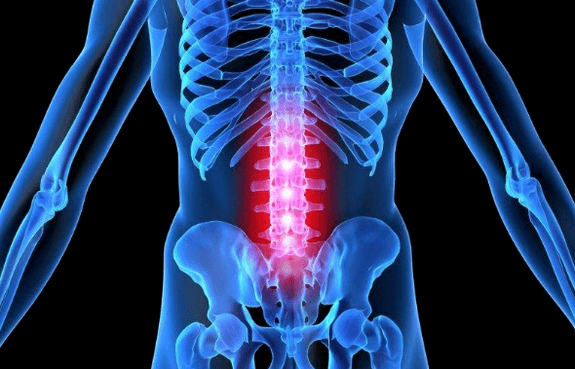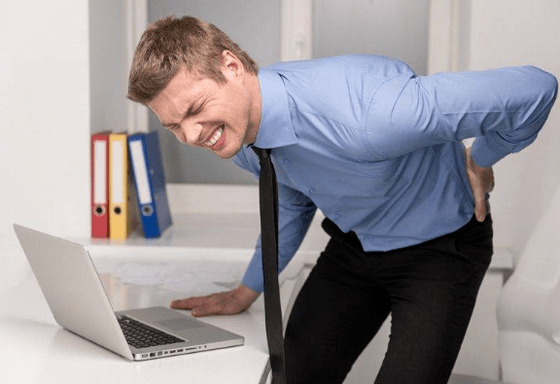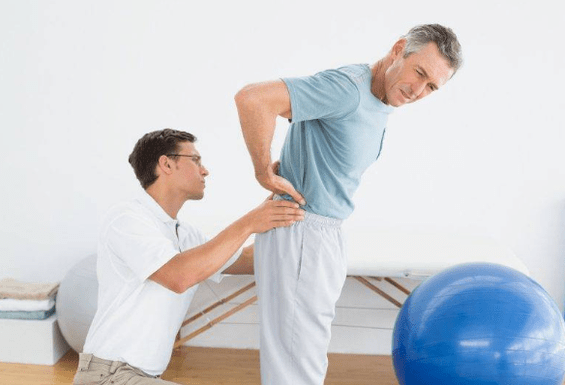The lower back pain most often affects people after 35 years.In most cases, the disease is associated with vertebral deformation and its consequences.Timely appeals to doctors will accelerate recovery, as the symptoms and treatment of lumbar spinal osteochondrosis are interconnected concepts.

The greater the progress of the disease, the more serious as a result, the more difficult the health recovery process.
Signs and symptoms of lumbar spinal osteochondrosis
The lumbar region is located between the sacrum and the chest department and consists of five vertebraes connected to the intervertebral disc.
The development of osteochondrosis means wearing an intervertebral disc that plays a role that absorbs in the load on the spine.The disc base is a mass like gel, protected by compact fibrous rings and cartilage, and the inner space is filled with liquid pulpoose core.
Due to the load on the vertebra, the elasticity and flexibility of the intervertebral disc disappears, disappear, as their height, and the microccrow is formed in fibrous rings, which over time causes its rupture and damage to the pulp nucleus.
The destruction of tissue is accompanied by nerve root pinches located on both sides of the vertebra and causes severe pain.
The main signs of lumbar osteochondrosis:
- back pain;
- fatigue and depression;
- weakness or excessive muscle tension;
- loss of sensitivity in limbs, buttocks or hips;
- pain and pain in the lower back, often giving to the feet;
- Violation of motor function.
Against the background of serious vertebral lesions, other symptoms are also observed in the lumbar region, most often, other organ dysfunction - urinary and sexual system, gastrointestinal tract.
Cause
Like most diseases of the musculoskeletal system, osteochondrosis can develop for many reasons.Some of them lie in lifestyle and diet, other parts develop with the background of body physiological features.
Often, the treatment of lumbosacral spinal osteochondrosis is needed by athletes whose backs are subject to not only the burden of power, but also to periodic injuries.
The second category of at risk, people who, based on their profession, spend a lot of time in one position - teachers, hairdressers, cooks, loaders, waiters, programmers, office workers and drivers.
Other reasons for pathological development:
- Overweight;
- violation of metabolism;
- Incorrect posture, bowing;
- genetic tendency;
- injury;
- bad habits;
- lack of beneficial trace elements and vitamins in the diet;
- abnormal development of the muscle bone system, flat feet;
- hypothermia;
- sediment, static;
- Frequent pressure.
All of the factors listed may affect the elasticity of the intervertebral disc, as they contribute to blood circulation or the appearance of nutrients entering the vertebrate.
The degree of lumbar spine osteochondrosis
Depending on the degree of damage to the spine, four degrees of development of the osteochondrial process are distinguished, created gradually when the disease develops.
First degree.
The pathological process of the spine begins far before their first clinical manifestation.As a result, loss of moisture, the intervertebral disc becomes less elastic.The height of the disc is kept normal.The patient feels uncomfortable at the bottom.
Second degree.
Against the background of moisture deficiency, the microcabot appears in the fibrous ring, and the tissue inflammation develops.The vertebral hook gradually increases.In the cartilage there is a seal.The patient complains of back pain, giving his feet or thighs.It is possible to limit motor capabilities.In the work of the internal organs, failure occurs.
Third degree.
The integrity of the fibrous ring is interrupted, the intervertebral disc flows out, forming a hernia.The vessels and nerve endings are compressed.Muscle cramps, pelvic organ dysfunction, lower leg sensitivity disorders, prolonged radiculitis attacks are observed.
Fourth degree.
Most complex, unacceptable for treatment, the current level of disease.As a result of the complete destruction of the intervertebral disc, scars are formed in their place.The vertebrae is maximum and gradually changes.With the development of spinal cord compression, lower leg paralysis is possible.
Diagnostics
To recognize the disease and determine the right diagnosis, neurologists use complex steps - history of anamnesis, physiological examination and hardware studies.

Hang -up collection.
Provide a patient complaint study:
- Causes of anxiety;
- place of localization of discomfort;
- unpleasant duration and intensity of sensation;
- duration of disease;
- possible causes of disease;
- frequency of anxiety;
- Factors that cause problems;
- Factors that improve well -being.
In addition, doctors study information about the patient's lifestyle, diet, labor and rest, presence of bad habits, hereditary factors and injury.
Physiological examination.
It is done to determine the pathological change and make an initial diagnosis.
During the examination, the doctor evaluates the ability of the patient's motor - Gait, posture, amplitude and the amount of movement.The palpation method examines the condition of the muscles - tone, size, amount of cramps.Using small tingles, it sets the level of sensitivity.Taping with a hammer makes it possible to know the area of pain irradiation.
Hardware research
For complete and accurate information on the location of the pathology and the level of tissue lesions, doctors use research through various types of medical equipment.
Radiography.Lumbar region studies through X -Ray allow us to establish the anatomical parameters of the vertebral and intervertebral discs, a tendency to narrow the holes between the base, the presence of bone growth.
Tomography.The use of electromagnetic waves provides the image output of the area studied to the screen for further study and analysis of the condition of the blood vessels that feed the spinal tissue, the nerve process and the intervertebral disc.
Ct.Pictures of several segments of the spinal cord are performed using X -Ray radiation.The image is displayed on the monitor to determine the nature of the change in the vessel, the vertebral membrane and the spinal cord, and regional growth.
For differential diagnostics, various types of studies are used to eliminate pathology of other body systems.
Lumbosacral spinal osteochondrosis treatment
The duration and features of the treatment of lumbosacral osteochondrosis depend on the results of the diagnostic step.In the early stages of the development of the disease, conservative treatment is indicated.With more complex wounds from the spine, surgical intervention is used.
Optimal therapeutic effects are achieved through complex therapy, which provides the use of local drugs, physiotherapy, massage, and healing gymnastics.
Drug
To relieve the symptoms, non -–steroid drugs for internal and external use are prescribed - tablets, injections, ointments.In addition, chondroprotectors, neuroprotectors, diuretics, vitamins, muscle relaxants are used.
Drug treatment allows:
- eliminate pain;
- remove inflammation;
- rest muscle;
- Return the destroyed cartilaginus;
- improve blood circulation;
- reduce swelling;
- increase physical activity;
- Normalizing brain nutrition.
In acute pain, novocaine blockade that gives an immediate effect.
A people's remedy
Treatment with folk methods is effective as an additional remedy for drug therapy.The main techniques of traditional medicine are based on the use of plant materials, animal products and chemicals.
Based on various components, ointments and compression, decoctions and infusions are provided for internal and external use, as well as for therapeutic baths.
Physiotherapy for lumbar osteochondrosis
Physiotherapy procedures are a great way to restore the function of the spinal cord after damage to osteochondrosis.
The main physiotherapy method includes:
- Electrotherapy - exposure to poor electrical current to improve blood circulation in tissues;
- Magnetotherapy - the use of magnetic fields to restore tissue at cellular levels;
- Laser therapy - comprehensive activation of biological processes in vertebrates and nerve endings;
- Shock wave therapy in the micro-circulation and metabolic processes in the affected tissue with acoustic waves;
- Balneotherapy - the use of mineral water healing properties.

Physiotherapy procedures not only increase the effectiveness of drug treatment, but also contribute to overall healing and strengthening of the body.
Massage for lumbar osteochondrosis
The visiting massage procedure is one of the most fun and effective methods for treating osteochondrosis.
Using a therapeutic sequence:
- eliminating muscle cramps;
- increase blood supply to the affected area;
- increase lymph flow;
- restore muscles that have revealed atrophy;
- Remove mobility restrictions.
Massage is prescribed when the pain syndrome is eliminated.
Therapeutic gymnastics
The main task of exercise therapy for osteochondrosis is to restore spinal function and its correction.However, you can attend classes only after eliminating severity symptoms.
The most effective therapeutic training methods are considered:
- charger;
- visit the gym;
- Water therapy, swimming.
At home, you can use a loop for sports.Some doctors to restore spinal flexibility recommend yoga lessons to their patients.
Excessive osteochondrosis training
Any exercise for osteochondrosis must be done slowly and without sudden movement.
To strengthen the muscles that support the vertebra, approach the training done in the stomach.In this case, the hand is stretched with a little sip, but without tension.Repeat 4 times.
Surgical intervention
They use spinal treatment in cases of extremely difficult cases - with significant neurological disorders, as well as in the event of loss of control over bowel movement.
In the course of the surgical intervention, the removal of the source of the disease was determined, and the steps were taken to stabilize the spine.The postoperative period lasts several months.
Why is lumbar lumbar osteochondrosis?
Degenerative changes that occur with lumbar osteochondrosis contribute to the development of many diseases that are harmful to human life.Against the background of intervertebral hernia, protrusion, lumbago and Ishias arise.
Further progress of the disease can lead to the fall of the intervertebral disc and the formation of Spinoz.In addition to the severe pain that accompanies the pathology, the ability of a person's motor to be violated, thus losing them.Paralysis from the lower leg develops.
With significant damage to the spinal cord, death is inevitable.
Prevention
To avoid changes that damage the spine, you need to maintain a healthy lifestyle:
- doing sports - swimming, hardening;
- adhere to a balanced, good nutrition;
- excluding bad habits;
- Save posture;
- Support the spine while sleeping using orthopedic mattresses.
In addition, it is advisable to prevent hypothermia, lifting weight.Women are not recommended to wear high shoes.
You can maintain lumbar health if you adjust your lifestyle and do not forget the importance of physical activity.


















